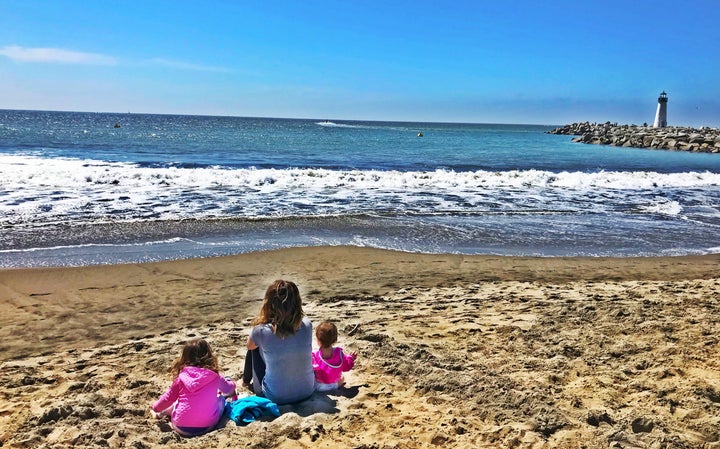
“Mama, what color am I?”
The question came innocently enough, over a year ago, as my (then) two-year-old daughter Gabi and I were playing with dolls in her room, all of which varied in skin colors and hair types.
“Well, what color do you think you are?” I responded, wanting Gabi to frame it in her own words. She scrunched up her face as she thought. I waited, not wanting to rush her.
“Ummmm… a little brown and a little white,” she finally said. “That’s right! Mama’s brown and Dada’s white and you’re a perfect mix of both of us,” I answered, giving her a big hug.
I am Mexican-American with brown skin, dark hair and eyes, and my husband is of Irish and Polish decent, with fair skin, light eyes and blonde hair. Ahead of having children ― I also have a one-year-old ― my husband and I spoke openly about our desire to raise our kids with a clear understanding of their racial identity and comfortability with addressing those all-too-often probing questions from strangers such as “What are you?” or “Where are you from?”
Biracial and multiracial children are on the rise: New findings from Pew Research indicate that the number of multiracial or multiethnic infants has tripled since 1980, making up 14 percent of infants born in 2015. This growth coincides with the rise of interracial marriages, which has more than doubled in that time as well. Further, the U.S. Census Bureau predicts that by 2060, the number of multiracial Americans will be three times larger than it is now.
Despite the many families just like mine in the U.S., I still find that people are uncomfortable or unfamiliar with the concept of racially blended families, which maybe shouldn’t be that surprising. According to a 2017 Quinnipiac University poll, 66 percent of nonwhite respondents labeled prejudice a “very serious” problem, while only 39 percent of whites felt the same way.
The current president has not helped the existing racial landscape: According to the same poll, more than six in 10 Americans (63 percent) say that the level of hatred and prejudice in the United States has increased since Donald Trump was elected president, including seven in 10 nonwhites who feel this way.
“I find it hard to recount the exact number of times I have been asked invasive questions about the nature of my relationship with my children... It’s almost as if people cannot ― or don’t want to ― understand that families come in all shapes, sizes, colors and variations.”
I myself have had my fair share of ill-informed comments or experiences as a result of being a brown mother to two biracial daughters who ended up having fair skin like their father. I find it hard to recount the exact number of times I have been asked invasive questions about the nature of my relationship with my children or felt side-eyed glances when I go out in public without my husband beside us. It’s almost as if people cannot ― or don’t want to ― understand that families come in all shapes, sizes, colors and variations.
Some incidents have been downright racist, with people automatically assuming that I am the nanny to my own daughters. Others have been racially deaf tone, with people insisting that they “don’t see skin color” or “that they view everyone as the same color.” Although some of these encounters were initially hurtful, I turned them into learning lessons for myself and our family on how to address our individual and collective racial identities and our family’s story.
Knowing that kids are like little sponges, constantly absorbing and taking cues from everything around them, we decided to make race an early topic of conversation. This was seeded by talking about racial characteristics and associated cultural traditions before they began speaking. By pointing out skin colors and facial features in others, using our extended family and friends as examples, my husband and I have been able to help our kids not only see differences, but most importantly, celebrate them.
I’ve shown my toddler daughter Gabi old family photo albums from both sides of our family because I want her eyes to be open to the fact that our extended family members come in all different shades, body types, eye shapes, nose sizes, hair colors, statures, and be comfortable with the fact that no one person looks exactly the same. In doing so, we’ve established comfortability for them to be their own person, be confident, and know that they don’t have to fit into any specific box, for themselves or anyone else.
Every time we visit my grandma or my husband’s mom for the holidays, I watch our girls seamlessly transition between making tamales, speaking Spanish and salsa dancing with their Abuelita to making pancakes, creating their latest artistic masterpiece and decorating our family Christmas tree with their Nana. We continually invite our kids to participate in these family traditions and create new, blended celebrations together.
This comfortability extends far beyond our family as well: we’ve made it a point to enroll our toddler daughter in a very diverse preschool, where the majority of families are biracial or multiracial and come from different income backgrounds. As a Spanish immersion school, the kids are spoken to primarily in Spanish, and learn the culture and backgrounds of all of their Latina teachers throughout the year. During a recent family tree project presentation, my husband and I proudly sat with the other parents in the audience as Gabi showcased her very diverse-looking family tree and genuinely inquired about her classmates’ trees (“Is that your Abuelita?”), all while speaking both in English and Spanish.
“How can you know who you are if you don’t know where and who you come from?”
Family narratives, individual and collective, not only provide a foundation for each member, but also help each family to work through their own story. After all, how can you know who you are if you don’t know where and who you come from? By placing value on our collective story for our children, we have communicated to them that race is an important topic, one that shouldn’t be minimized. I want to prepare them to confidently handle conversations about race, and feel that they have the tools to assertively address inappropriate or racist questions, assumptions or stereotypes.
Growing up as one of the only brown kids in a very homogeneous, insular, upper-class white area of Southern California, I didn’t know racism existed until I was hit over the head with it on multiple occasions, and then left reeling after the fact. As a result, I didn’t want race to be an afterthought topic of conversation ― a postscript on our lessons taught to our children, which could be easily brushed off or pushed under the rug.
While they are still too young to fully grasp the weight of my words, I want our children to know there is a correlated perceived value system and privilege association with the color spectrum. I want them to understand that racism can be stark and distinct ― a slur yelled from a passing car ― or nuanced and varied, hiding behind a smile or an innuendo.
Recent events like the arrest of two black men at a Philadelphia Starbucks show inherent bias toward certain members of society and privilege toward others. It is an unfortunate reality that our society is still extremely divided on the topic of race, neglecting to see or make the effort to understand how the racial experience is different for everyone.
I don’t want my daughters to be blind to race. I want them to feel strong in their knowledge and understand that their voice is powerful. I want them to know their opinion is important and no one should ever make them feel less than. By engaging with them on the topic early on and providing the necessary tools, my hope is that my daughters will be better prepared to take on the world, lead with compassion and intellect, and stand resolute in the face of challenges.
Do you have a personal story you’d like to see published on HuffPost? Find out what we’re looking for here and send us a pitch!
